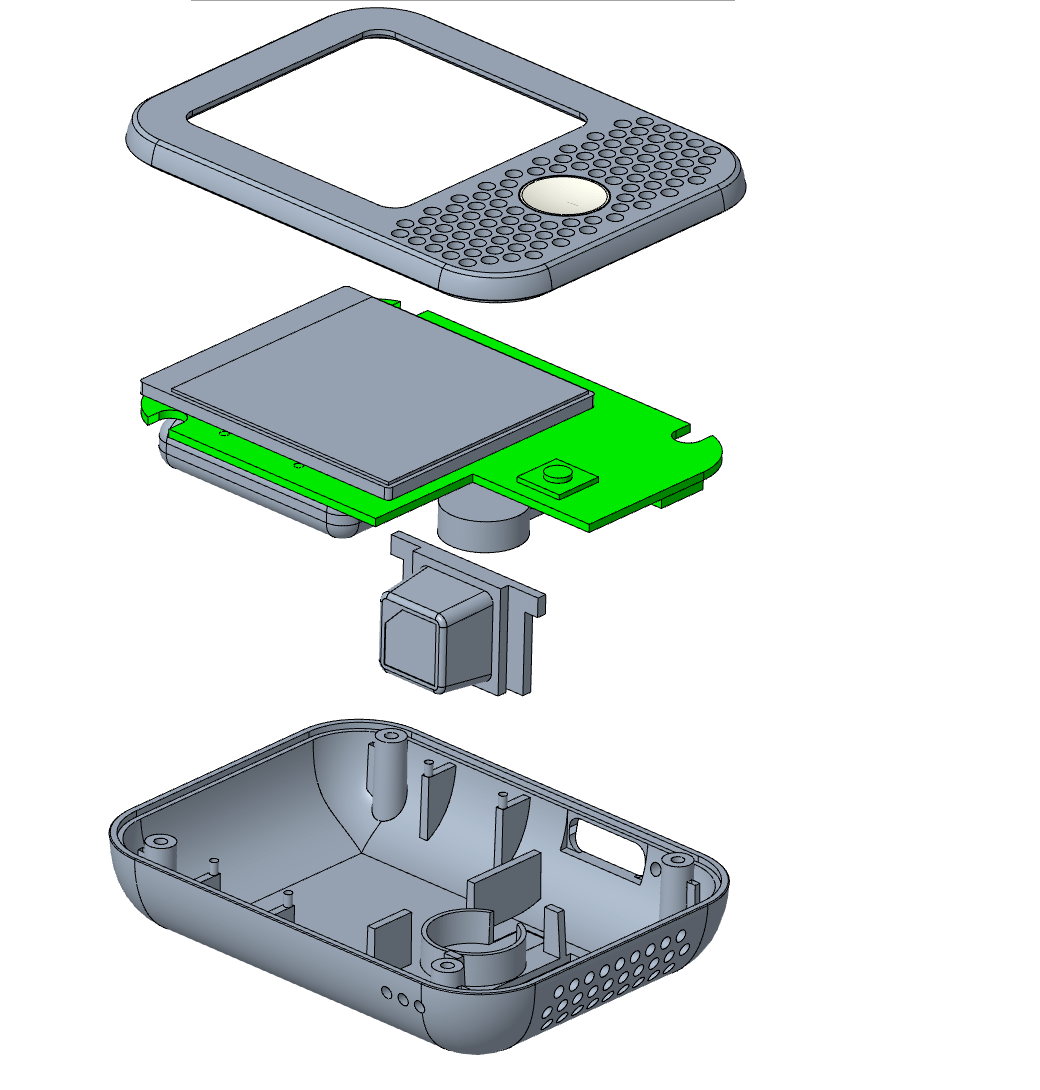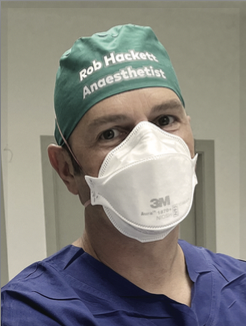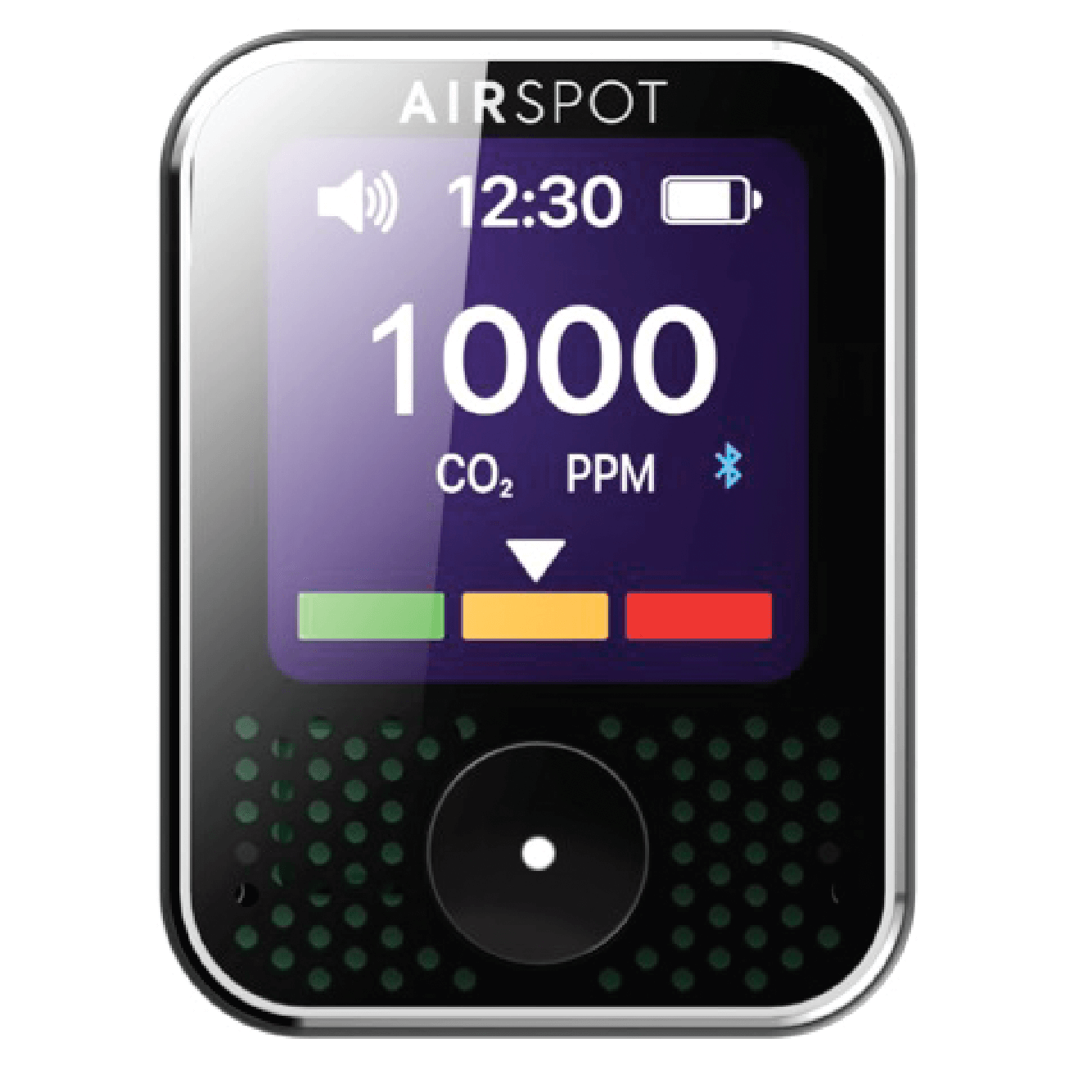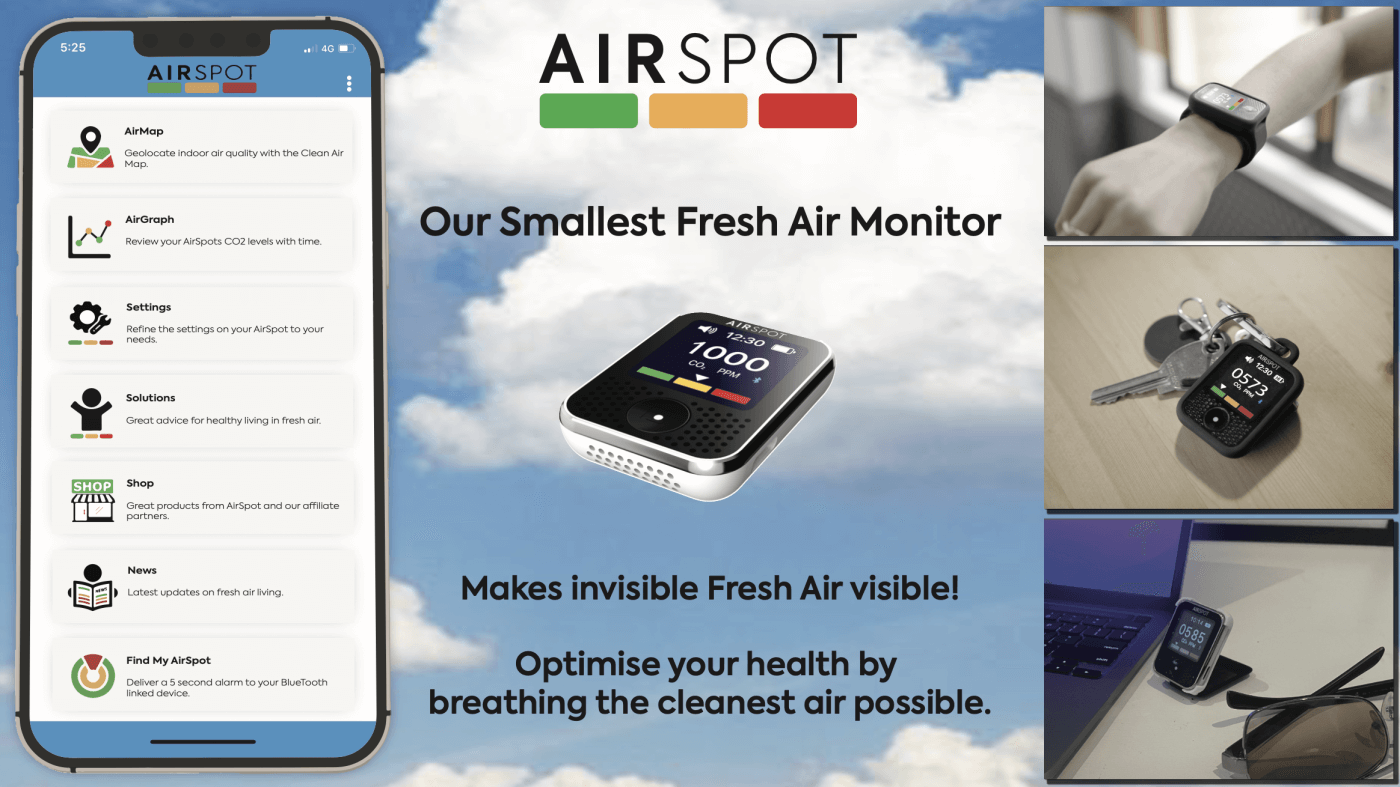So how did the AirSpot concept start and how is it going?
May 2022
An email sent on 18th May 2022 to my ecommerce manager Liam Byrne (who was prompting me to sell more on the TheatreCaps website) was really the start of our project:
Liam - help save humanity from this slow burn extinction event
My initial thoughts were for something slimline that could be a mobile phone case (and yes we'll certainly keep looking to make our device smaller and smaller and eventually aim to get it into smartphones themselves). Liam suggested a tag - which could be carried anywhere - that's where AirSpot began to take shape.
It was then a case of finding the best and smallest components we could.
The device weighs a mere 17g, (a third the weight of a chicken egg), so is easy to cary around. We believe it represents the smallest portable carbon dioxide monitor on the market at 3.6cm x 4.8cm x 1.2cm. It is charged using the 5V USB C cable provided.
The secret device which makes AirSpot so tiny is the Sensirion SCD41 sensor which is as accurate as older NDIR sensors but a fraction of the size.
Accuracy is ± 40 ppm + 5% of reading. Battery life is up to 5 days when reading once per 3 minutes.
July 2022
Based on the componentry, screen and battery size we were able to come up with 3 initial concept designs
September 2022
We received our first prototype in September 2022. It was apparent from the beginning that the position of the button needed to be changed from the side to the front to make it easier to press with one digit.
October 2022
We wanted to provide as much feedback from the device to the user as possible. A vibration motor became a must. So we needed to work out how to fit one in. We cover sight, sound, touch and these we needed the user to have control over what would trigger these senses to be stimulated.
December 2022
Despite a few modifications with additional air holes the AirSpot shell had been developed by December 2022
Early trials on the train with a 3D printed wrist strap (remember those signs on the floor):
Given the shell shape was pretty much settled we were able to also work on developing the accessories:
Our accessories have undergone (and continue to undergo) continuous refinement and improvement to make them as user friendly as possible.
March 2023
By March 2023 we had our first version of the AirSpot App ready for release
May 2023
We were developing packaging concepts for the AirSpot device and accessories
Throughout 2023 the AirSpot website was being developed.
With the input of our design guru Amy Lewis everything has taken on a new lease of life:
August 2023
We offered a pre-launch product to future customers at a discounted price with the aim to have it with them by the end of the month. This was pending our 5th prototype being up to our standards - unfortunately it was not.
It was a bit upsetting to let these customers know we wouldn't be able to deliver a quality product to them in time.
We realised there was need or a more powerful memory chip and the ability to perform upgraded of the device through the AirSpot App.
This has been much of our focus from the end of 2023 to early 2024. The App has been improved, the device itself has been greatly improved and we've had additional time to focus on improving the accessories and packaging.
We've also employed Mabel Zhang to smooth communications with our Chinese developers and it's working a treat.
Each AirSpot Device will be packaged with a stand/wall mount, USB C cable, AirSpot stickers and Instruction Manual.
The latest version of the wrist strap is as below, as thin as possible (without a back), the AirSpot Device clicks snuggly into place in a hard plastic shell and the 22mm width silicone pin attached wrist strap is interchangeable:
The clip on carry case is made of flexible silicone with a metal ring:
March 2024
The AirSpot App is on it's second version and is free for download on the App Store and Google Play. We're extremely happy with how it runs.
We're about to receive our 6th device prototype and from everything we've seen we're looking to head towards full development of our first 1000 devices after it's review.
So this really is your chance to get in early and get yours at a greatly discounted price.
The money we generate through crowd sourced funding will go towards payment for this first 1000 unit development and continually improving the product and functionality it can deliver.
We're very excited.
Let us know if you have any questions.
Rob
We've all heard the saying - 'you are what you eat' - yet with the advent of the pandemic it's become more apparent that 'you are what you breathe'.
Our aim is to make it as easy as possible to breathe the best air there is.
We've all heard the saying - 'you are what you eat' - yet with the advent of the pandemic we’ve learned that 'you are what you breathe'.
Our aim is to make it as easy as possible to breathe the best air we can.
Why AirSpot?
Caring about AirHealth is incredibly important, as the quality of the air we breathe has significant impacts on our health and overall well-being. But what is the AirHealth of your indoor environments, and how can you measure it?
When we breathe we exhale carbon dioxide (CO2). Its accumulation can be a sign of poor ventilation. Elevated CO2 levels means stale air, which can lead to a range of health issues including headaches, fatigue, and poor concentration.
That drowsy feeling you’ve experienced in a stuffy conference room? Likely to be high levels of CO2 in the air.
As we've seen with the pandemic, indoor spaces are high risk environments for the transmission of airborne viruses – particularly when ventilation is poor, so understanding the health of the air around you is so crucial – AirHealth.
CO2 levels act as a kind of sentinel, offering valuable insights into your AirHealth, and the opportunity to improve it where necessary.
How do I use it?
Existing CO2 monitors can be clunky and unwieldy objects, not really well suited for personal or day-to-day use. We wanted to change this, by designing a device for everyday people to use in their everyday lives.
AirSpot is small (3.6cm x 4.8cm x 1.2cm), light (17g) and unobtrusive and can be used in a variety of different ways. You can clip it to your bag or belt buckle, sit it on your desk or even wear it on your wrist so keeping track of your AirHealth can be quick, discreet and simple.
What are the devices specifications?
The AirSpot device weighs a mere 17g, (a third the weight of a chicken egg), so is easy to cary around. We believe it represents the smallest portable carbon dioxide monitor on the market at 3.6cm x 4.8cm x 1.2cm. It is charged using the 5V USB C cable provided.
The secret device which makes AirSpot so tiny is the Sensirion SCD41 sensor which is as accurate as older NDIR sensors but a fraction of the size.
Accuracy is ± 40 ppm + 5% of reading. Battery life is up to 5days when reading once per 3 minutes.
Who is in the team?
Hello my name is Dr Rob Hackett,
I'm an anaesthetist with a passion for safety through making it easier for us all to succeed in have a better and safer life.
My journey to change improvement has been fired up during the pandemic.
It's led to my meeting this truly amazing team:
Peter Vogel - inventor of perhaps Australia's most amazing device that few know about; lawyer; so so much more, even wikipedia can't cover the many things he's done.
Shaun Ralph - every successful business project needs a great accountant. We've got the best - a thoroughly lovely guy and amazing communicator.
When did the project start?
The concept began through an email sent on 17th May 2022 from myself to Liam Byrne - to design and market the smallest most user friendly, personal and wearable fresh air monitor we could.
This was the beginning of AirSpot.
How is the project progressing?
The team is thrilled by recent progress .
The first pilot production was completed in late 2023 and although performance was excellent we decided to add a memory chip to add logging and historical plotting functionality. This also enabled device and app updates to be driven “over the air” from the AirSpot app.
After much fine tuning of tooling, the shell of the device is now perfect and this has allowed us to focus on improving the accessories for carrying the device while continuing to develop the device’s functionality and the AirSpot App.
The AirSpot App is live and is free for download through Google Play and the App Store. It's just had its second major update.
We are due to assess our latest (5th version) prototype device in mid-March 2024. After review, if we're happy with the quality, we will go into production with our first 1000 units. This is where much of the crowd funding money - the AU$20,000 will go.
Risks and challenges
Any project carries potential risks, such as delays in the final manufacturing schedule due to supply chain challenges and other factors. We’re working really hard to prepare for challenges that may arise during this campaign and we are committed to transparency and will keep you informed while actively working to resolve any issues if any should arise. If you have any questions or concerns, we would definitely encourage you to contact us.
Environmental commitments
AirSpot has been designed with durability in mind. It is designed to switch easily between various stands and wrist straps to cut down on resources. Wherever possible the single use plastics are avoided, and we use recycled materials for shipping wherever possible.
How can you get involved?
We're offering fantastic perks to get you interested in helping us achieve our goal. These perks will only last until we go to market which we hope will occur in late 2024.
So please get on board, help out and share this project with as many people as you can.
We aim to create a better safer world for everyone and hope you'll join us on the ride.
Thank you.
Dr Rob





















